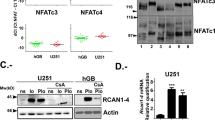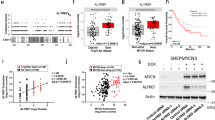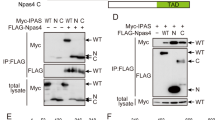Abstract
Id1 is a helix–loop–helix transcriptional factor that controls growth and survival of neuronal cells. Downregulation of Id1 expression is required to initiate differentiation and cell-cycle withdrawal in primary neuronal culture as well as in PC12 cells. The HIV-1 transactivating factor, Tat, has been suspected of causing neuronal dysfunction that often leads to the development of HIV-associated dementia in AIDS patients. We found that the expression of Tat in PC12 cells promotes serum-independent growth, formation of large colonies in soft agar, and the acceleration of tumor growth in nude mice. In addition, Tat showed the ability to inhibit the nerve growth factor (NGF)-induced neuronal differentiation of PC12 cells. Our results show that the Tat-mediated signaling events, which lead to serum-independent growth and the inhibition of NGF-induced differentiation, have a common cellular target: the upregulation of Id1 expression. In the absence of NGF, expression of Id1 is required to promote serum-independent proliferation of PC12/Tat cells, as the inhibition of Id1 by antisense DNA restored the serum-dependent growth of PC12/Tat cells. In the presence of NGF, Tat utilizes an additional pathway that involves phosphorylation of Stat5a, to upregulate Id1 expression and block neuronal cell differentiation. Suppression of Stat5a by use of its dominant-negative mutant reversed the transient expression of Id1 and the blockage of NGF-mediated differentiation in PC12/Tat cells. Finally, the treatment of PC12 cells with recombinant Tat also enhanced the NGF-induced Id1 expression, further pointing to Id1 as a target for Tat. Taken together, these studies suggest additional targets for Tat action in neuronal cells and provide new insights into the mechanisms involved in the dysregulation of neuronal functions.
This is a preview of subscription content, access via your institution
Access options
Subscribe to this journal
Receive 50 print issues and online access
$259.00 per year
only $5.18 per issue
Buy this article
- Purchase on Springer Link
- Instant access to full article PDF
Prices may be subject to local taxes which are calculated during checkout







Similar content being viewed by others
References
Belletti B, Drakas R, Morrione A, Tu X, Prisco M, Yuan T, Casaburi I and Baserga R . (2002). Exp. Cell Res., 277, 107–118.
Benezra R, Davis RL, Lassar A, Tapscott S, Thayer M, Lockshon D and Weintraub H . (1990a). Ann. NY Acad. Sci., 599, 1–11.
Benezra R, Davis RL, Lockshon D, Turner DL and Weintraub H . (1990b). Cell, 61, 49–59.
Borgatti P, Zauli G, Cantley LC and Capitani S . (1998). Biochem. Biophys. Res. Commun., 242, 332–337.
Bovolenta C, Camorali L, Lorini AL, Ghezzi S, Vicenzi E, Lazzarin A and Poli G . (1999). Blood, 94, 4202–4209.
Bovolenta C, Pilotti E, Mauri M, Panzeri B, Sassi M, Dall’Aglio P, Bertazzoni U, Poli G and Casoli C . (2002). J. Immunol., 169, 4443–4449.
Bowman T, Garcia R, Turkson J and Jove R . (2000). Oncogene, 19, 2474–2488.
Cai L, Morrow EM and Cepko CL . (2000). Development, 127, 3021–3030.
Caldenhoven E, van Dijk TB, Tijmensen A, Raaijmakers JA, Lammers JW, Koenderman L and de Groot RP . (1998). Stem Cells, 16, 397–403.
Cantaluppi V, Biancone L, Boccellino M, Doublier S, Benelli R, Carlone S, Albini A and Camussi G . (2001). AIDS Res. Hum. Retroviruses, 17, 965–976.
Chen P, Mayne M, Power C and Nath A . (1997). J. Biol. Chem., 272, 22385–22388.
Coffer PJ, Koenderman L and de Groot RP . (2000). Oncogene, 19, 2511–2522.
Cordle SR, Henderson E, Masuoka H, Weil PA and Stein R . (1991). Mol. Cell. Biol., 11, 1734–1738.
de la Fuente C, Santiago F, Deng L, Eadie C, Zilberman I, Kehn K, Maddukuri A, Baylor S, Wu K, Lee CG, Pumfery A and Kashanchi F . (2002). BMC Biochem., 3, 14.
De-Fraja C, Conti L, Govoni S, Battaini F and Cattaneo E . (2000). Int. J. Dev. Neurosci., 18, 439–446.
Desprez PY, Hara E, Bissell MJ and Campisi J . (1995). Mol. Cell. Biol., 15, 3398–3404.
Desprez PY, Lin CQ, Thomasset N, Sympson CJ, Bissell MJ and Campisi J . (1998). Mol. Cell. Biol., 18, 4577–4588.
Einarson MB and Chao MV . (1995). Mol. Cell. Biol., 15, 4175–4183.
Ensoli B, Buonaguro L, Barillari G, Fiorelli V, Gendelman R, Morgan RA, Wingfield P and Gallo RC . (1993). J. Virol., 67, 277–287.
Ensoli F, Ensoli B and Thiele CJ . (1994). Virology, 200, 668–676.
Gaynor RB . (1995). Curr. Top. Microbiol. Immunol., 193, 51–77.
Groner B, Fritsche M, Stocklin E, Berchtold S, Merkle C, Moriggl R and Pfitzner E . (2000). Growth Horm. IGF Res., 10 (Suppl B), S15–S20.
Israel MA, Hernandez MC, Florio M, Andres-Barquin PJ, Mantani A, Carter JH and Julin CM . (1999). Cancer Res., 59, 1726s–1730s.
Kaul M, Garden GA and Lipton SA . (2001). Nature, 410, 988–994.
Klein JA, Longo-Guess CM, Rossmann MP, Seburn KL, Hurd RE, Frankel WN, Bronson RT and Ackerman SL . (2002). Nature, 419, 367–374.
Klesse LJ, Meyers KA, Marshall CJ and Parada LF . (1999). Oncogene, 18, 2055–2068.
Kreider BL, Benezra R, Rovera G and Kadesch T . (1992). Science, 255, 1700–1702.
Kruman II, Nath A and Mattson MP . (1998). Exp. Neurol., 154, 276–288.
Lin CQ, Singh J, Murata K, Itahana Y, Parrinello S, Liang SH, Gillett CE, Campisi J and Desprez PY . (2000). Cancer Res., 60, 1332–1340.
Lotz M, Clark-Lewis I and Ganu V . (1994). J. Cell Biol., 124, 365–371.
Lyden D, Young AZ, Zagzag D, Yan W, Gerald W, O’Reilly R, Bader BL, Hynes RO, Zhuang Y, Manova K and Benezra R . (1999). Nature, 401, 670–677.
Merrill JE, Koyanagi Y, Zack J, Thomas L, Martin F and Chen IS . (1992). J. Virol., 66, 2217–2225.
Milani D, Mazzoni M, Borgatti P, Zauli G, Cantley L and Capitani S . (1996). J. Biol. Chem., 271, 22961–22964.
Milani D, Mazzoni M, Zauli G, Mischiati C, Gibellini D, Giacca M and Capitani S . (1998). Aids, 12, 1275–1284.
Milani D, Zauli G, Neri LM, Marchisio M, Previati M and Capitani S . (1993). J. Gen. Virol., 74 (Part 12), 2587–2594.
Min Xu, Lei Nie, Seung-Hwan K and Xiao-Hong S . (2003). EMBO J., 22, 893–904.
Moriggl R, Gouilleux-Gruart V, Jahne R, Berchtold S, Gartmann C, Liu X, Hennighausen L, Sotiropoulos A, Groner B and Gouilleux F . (1996). Mol. Cell. Biol., 16, 5691–5700.
Nagata Y and Todokoro K . (1994). Biochem. Biophys. Res. Commun., 199, 1355–1362.
Nath A, Psooy K, Martin C, Knudsen B, Magnuson DS, Haughey N and Geiger JD . (1996). J. Virol., 70, 1475–1480.
Nehlin JO, Hara E, Kuo WL, Collins C and Campisi J . (1997). Biochem. Biophys. Res. Commun., 231, 628–634.
Nguyen KB, Watford WT, Salomon R, Hofmann SR, Pien GC, Morinobu A, Gadina M, O'Shea JJ and Biron CA . (2002). Science, 297, 2063–2066.
Norton JD, Deed RW, Craggs G and Sablitzky F . (1998). Trends Cell Biol., 8, 58–65.
Onishi M, Nosaka T, Misawa K, Mui AL, Gorman D, McMahon M, Miyajima A and Kitamura T . (1998). Mol. Cell. Biol., 18, 3871–3879.
Peruzzi F, Prisco M, Dews M, Salomoni P, Grassilli E, Romano G, Calabretta B and Baserga R . (1999). Mol. Cell. Biol., 19, 7203–7215.
Ramirez SH, Sanchez JF, Dimitri CA, Gelbard HA, Dewhurst S and Maggirwar SB . (2001). J. Neurochem., 78, 874–889.
Recio JA and Aranda A . (1997). J. Biol. Chem., 272, 26807–26810.
Reiss K, D’Ambrosio C, Tu X, Tu C and Baserga R . (1998). Clin. Cancer Res., 4, 2647–2655.
Reiss K, Tu X, Romano G, Peruzzi F, Wang JY and Baserga R . (2001). Clin. Cancer Res., 7, 2134–2144.
Riechmann V, van Cruchten I and Sablitzky F . (1994). Nucleic Acids Res., 22, 749–755.
Sastry KJ, Reddy HR, Pandita R, Totpal K and Aggarwal BB . (1990). J. Biol. Chem., 265, 22018–20093.
Seve M, Favier A, Osman M, Hernandez D, Vaitaitis G, Flores NC, McCord JM and Flores SC . (1999). Arch. Biochem. Biophys., 361, 165–172.
Shi B, Raina J, Lorenzo A, Busciglio J and Gabuzda D . (1998). J. Neurovirol., 4, 281–290.
Wang YJ, Peruzzi F, Lassak A, Del Valle L, Radhakrishnan S, Rappaport J, Khalili K, Amini S and Reiss K . (2003). Virology, 305, 66–76.
Wilson RB, Kiledjian M, Shen CP, Benezra R, Zwollo P, Dymecki SM, Desiderio SV and Kadesch T . (1991). Mol. Cell. Biol., 11, 6185–6191.
Wu YY and Bradshaw RA . (1996). J. Biol. Chem., 271, 13033–13039.
Wu YY and Bradshaw RA . (2000). J. Biol. Chem., 275, 2147–2156.
Zauli G, Gibellini D, Caputo A, Bassini A, Negrini M, Monne M, Mazzoni M and Capitani S . (1995). Blood, 86, 3823–3834.
Zauli G, Gibellini D, Milani D, Mazzoni M, Borgatti P, La Placa M and Capitani S . (1993). Cancer Res., 53, 4481–4485.
Zhong H, Lee D, Robeva A and Minneman KP . (2001). Life Sci., 68, 2269–2276.
Acknowledgements
We thank members of the Center for Neurovirology and Cancer Biology for their helpful comments and sharing of reagents. We also thank J Otte for technical support and C Schriver for editorial assistance. This work was supported by NIH grants awarded to SA.
Author information
Authors and Affiliations
Corresponding author
Rights and permissions
About this article
Cite this article
Bergonzini, V., Delbue, S., Wang, J. et al. HIV-Tat promotes cellular proliferation and inhibits NGF-induced differentiation through mechanisms involving Id1 regulation. Oncogene 23, 7701–7711 (2004). https://doi.org/10.1038/sj.onc.1207828
Received:
Revised:
Accepted:
Published:
Issue Date:
DOI: https://doi.org/10.1038/sj.onc.1207828
Keywords
This article is cited by
-
HIV-1 Tat targets Tip60 to impair the apoptotic cell response to genotoxic stresses
The EMBO Journal (2005)



